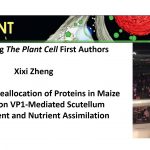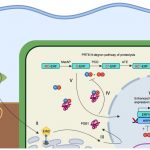Plant Science Research Weekly: Sept. 20th
Review: Plant networks as traits and hypotheses: Moving beyond description ($)
 In Star Wars Episode 2, Obi Wan identifies the location of a missing planet by walking through a 3D projection of the galaxy. I’ve always hoped that if we obtain enough data and figure out how to display it properly, we’ll “see” what parts are out of place or missing. But getting from simple linear models (“A leads to B, which leads to C”) to multidimensional models requires learning new ways of analyzing and presenting data. In this review, Marshall-Colón and Kliebenstein tackle this topic. They first introduce the idea that gene regulatory networks can be created from transcriptomic data, made even more illuminating when data from multiple time points are combined. They describe the usefulness of eigengenes, clusters of functionally-related genes that can be grouped for greater power. Of course, finding patterns within huge datasets requires the use of appropriate statistical tools as well as machine-learning approaches, several of which are presented here. Integrating across scales (e.g., genes and metabolites) lends additional power, as can integrating GWAS data with gene networks. The authors then describe how networks can produce testable hypotheses, using examples derived from nitrogen responses and specialized metabolite production. Finally, they observe the need for networks to be standardized for better sharing, and conclude by highlighting tools for enhanced visualization, including virtual reality. Perhaps Obi Wan’s world isn’t so far off. (Summary by Mary Williams) Trends Plant Sci. 10.1016/j.tplants.2019.06.003
In Star Wars Episode 2, Obi Wan identifies the location of a missing planet by walking through a 3D projection of the galaxy. I’ve always hoped that if we obtain enough data and figure out how to display it properly, we’ll “see” what parts are out of place or missing. But getting from simple linear models (“A leads to B, which leads to C”) to multidimensional models requires learning new ways of analyzing and presenting data. In this review, Marshall-Colón and Kliebenstein tackle this topic. They first introduce the idea that gene regulatory networks can be created from transcriptomic data, made even more illuminating when data from multiple time points are combined. They describe the usefulness of eigengenes, clusters of functionally-related genes that can be grouped for greater power. Of course, finding patterns within huge datasets requires the use of appropriate statistical tools as well as machine-learning approaches, several of which are presented here. Integrating across scales (e.g., genes and metabolites) lends additional power, as can integrating GWAS data with gene networks. The authors then describe how networks can produce testable hypotheses, using examples derived from nitrogen responses and specialized metabolite production. Finally, they observe the need for networks to be standardized for better sharing, and conclude by highlighting tools for enhanced visualization, including virtual reality. Perhaps Obi Wan’s world isn’t so far off. (Summary by Mary Williams) Trends Plant Sci. 10.1016/j.tplants.2019.06.003
Editorial and Special Issue. Biotechnology of the sweetpotato: Ensuring global food and nutrition security in the face of climate change
 Global food security is increasingly threatened by expanding industrialization and skyrocketing human populations set in the backdrop of dramatically shifting environmental conditions due to climate change. Innovations in agricultural practices and technology are required to overcome the unprecedented challenges posed by these conditions. In this editorial, Kwak suggests that the sweetpotato plant (Ipomoea batatas) is an ideal candidate crop for overcoming food insecurity in the twenty-first century. The sweetpotato uses water efficiently, reduces soil erosion, provides highly-nutritious fodder for humans and animals in all of its parts, tolerates a wide range of temperatures, and requires only a four-month frost-free period for development. These intrinsic qualities make the sweetpotato especially suited to food production in a precariously shifting climate, however Kwak takes it a step further by calling for the development of a strategy to develop new cultivars of sweetpotato by introducing genes that allow them to tolerate greater temperature ranges, produce higher yields on marginal lands, and enhance metabolic pathways. These introduced traits will lend the sweetpotatoes of the future even greater global agricultural importance and have the potential to robustly address food insecurity. The editorial includes links to several articles in the forthcoming special issue on sweetpotato biotechnology. (Summary by Rebecca Hayes) Plant Cell Reports 10.1007/s00299-019-02468-0 Image from Wikipedia
Global food security is increasingly threatened by expanding industrialization and skyrocketing human populations set in the backdrop of dramatically shifting environmental conditions due to climate change. Innovations in agricultural practices and technology are required to overcome the unprecedented challenges posed by these conditions. In this editorial, Kwak suggests that the sweetpotato plant (Ipomoea batatas) is an ideal candidate crop for overcoming food insecurity in the twenty-first century. The sweetpotato uses water efficiently, reduces soil erosion, provides highly-nutritious fodder for humans and animals in all of its parts, tolerates a wide range of temperatures, and requires only a four-month frost-free period for development. These intrinsic qualities make the sweetpotato especially suited to food production in a precariously shifting climate, however Kwak takes it a step further by calling for the development of a strategy to develop new cultivars of sweetpotato by introducing genes that allow them to tolerate greater temperature ranges, produce higher yields on marginal lands, and enhance metabolic pathways. These introduced traits will lend the sweetpotatoes of the future even greater global agricultural importance and have the potential to robustly address food insecurity. The editorial includes links to several articles in the forthcoming special issue on sweetpotato biotechnology. (Summary by Rebecca Hayes) Plant Cell Reports 10.1007/s00299-019-02468-0 Image from Wikipedia
KonMari for Maize – keeping genomes clutter-free during selfing ($)
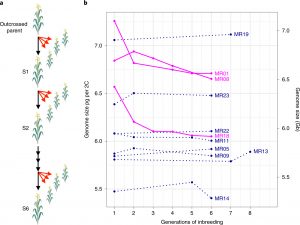 Just like years of hoarding can end up cluttering our homes, years of self-fertilization or selfing can also accumulate harmful mutations in plant genomes. By removing such harmful alleles from the genome (i.e., purging) plants can reduce the mutational load and prevent fitness loss due to selfing. Roessler et al. took a close look at the immediate genomic consequences of purging by examining eleven maize lines that were selfed for six generations. They found that three of these selfed lines lost ~6% of their genomes through purging. Genome size loss was mainly due to a reduction in transposable element content (and to a lesser extent chromosomal knob-associated repeats) and not due to reduced ribosomal DNA or gene-content. Surprisingly, these lines retained heterozygosity at a higher rate than expected, and genomic regions with high heterozygosity were enriched in harmful alleles. Finally, high-recombining regions were more prone to rapid purging of harmful alleles than low-recombining regions. (Summary by Saima Shahid) Nature Plants 10.1038/s41477-019-0508-7.
Just like years of hoarding can end up cluttering our homes, years of self-fertilization or selfing can also accumulate harmful mutations in plant genomes. By removing such harmful alleles from the genome (i.e., purging) plants can reduce the mutational load and prevent fitness loss due to selfing. Roessler et al. took a close look at the immediate genomic consequences of purging by examining eleven maize lines that were selfed for six generations. They found that three of these selfed lines lost ~6% of their genomes through purging. Genome size loss was mainly due to a reduction in transposable element content (and to a lesser extent chromosomal knob-associated repeats) and not due to reduced ribosomal DNA or gene-content. Surprisingly, these lines retained heterozygosity at a higher rate than expected, and genomic regions with high heterozygosity were enriched in harmful alleles. Finally, high-recombining regions were more prone to rapid purging of harmful alleles than low-recombining regions. (Summary by Saima Shahid) Nature Plants 10.1038/s41477-019-0508-7.
Chemical screening pipeline for identification of specific plant autophagy modulators ($)
 Autophagy is a recycling pathway that supports numerous processes, from nutrient remobilization to abiotic and biotic stress responses. Dauphinee, Cardoso et al. have developed a multi-step pathway that allows them to screen for inhibitors of autophagy in order to build a repertoire of new tools. For a high-throughput screen of autophagy inhibition, they start by looking at a decrease in fluorescence of a marker due to its transport into the lytic vescicle, using cultured tobacco cells. Candidates are next screened in whole plants using a tandem tag assay: one fluorescent tag is pH sensitive so the ratio of fluorescence from the two tags reveals the distribution of the reporter, hence extent of nitrogen-starvation induced autophagy. They followed this with a time-course assay and a check for specificity, leading to the identification of several promising new autophagy inhibitors. (Summary by Mary Williams) Plant Physiol. 10.1104/pp.19.00647
Autophagy is a recycling pathway that supports numerous processes, from nutrient remobilization to abiotic and biotic stress responses. Dauphinee, Cardoso et al. have developed a multi-step pathway that allows them to screen for inhibitors of autophagy in order to build a repertoire of new tools. For a high-throughput screen of autophagy inhibition, they start by looking at a decrease in fluorescence of a marker due to its transport into the lytic vescicle, using cultured tobacco cells. Candidates are next screened in whole plants using a tandem tag assay: one fluorescent tag is pH sensitive so the ratio of fluorescence from the two tags reveals the distribution of the reporter, hence extent of nitrogen-starvation induced autophagy. They followed this with a time-course assay and a check for specificity, leading to the identification of several promising new autophagy inhibitors. (Summary by Mary Williams) Plant Physiol. 10.1104/pp.19.00647
Genome sequence of Striga asiatica provides insight into the evolution of plant parasitism
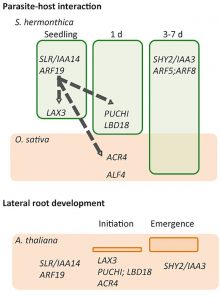 The parasitic plant Striga asiatica is both a serious agricultural pest and a fascinating plant oddity. Yoshida et al. report its genome sequence, which provides a glimpse into how a plant becomes an obligate parasite. Three key findings are the tremendous expansion of receptors for strigolactones (host-released signals that trigger Striga germination, leading to parasitism), the co-option of genes involved in lateral root development for the development of the pentrating haustorium, and evidence for the horizontal transfer of host genes into the Striga genome. They present a three-phase model of parasite evolution, which is consistent with the enhancement and contraction of key genes. (Summary by Mary Williams) Curr. Biol. 10.1016/j.cub.2019.07.086
The parasitic plant Striga asiatica is both a serious agricultural pest and a fascinating plant oddity. Yoshida et al. report its genome sequence, which provides a glimpse into how a plant becomes an obligate parasite. Three key findings are the tremendous expansion of receptors for strigolactones (host-released signals that trigger Striga germination, leading to parasitism), the co-option of genes involved in lateral root development for the development of the pentrating haustorium, and evidence for the horizontal transfer of host genes into the Striga genome. They present a three-phase model of parasite evolution, which is consistent with the enhancement and contraction of key genes. (Summary by Mary Williams) Curr. Biol. 10.1016/j.cub.2019.07.086
Two bifunctional inositol pyrophosphate kinases/phosphatases control plant phosphate homeostasis
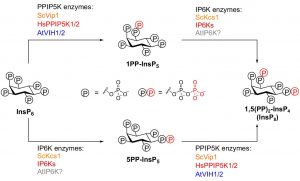 Phosphorus (P) is an essential macronutrient for plant growth and development. P is predominantly absorbed by plants in its inorganic form, phosphate (Pi). Because Pi homeostasis is critical for balanced growth and development, plants like many other eukaryotic organisms have developed a complex system that enables them to sense, uptake, transport, store and redistribute Pi. Some of the proteins mediating these functions have been previously shown to contain the SPX (SYG1/Pho81/XPR1) domain. This domain acts as a cellular receptor for the perception of pyrophosphate (PP-InsP). Further evidence has also shown that changes in the levels of PP-InsP regulate Pi homeostasis. Although the biosynthesis of PP-InsP is well understood in yeast and mammals, its biosynthesis and whether it truly regulates Pi homeostasis in plants is less clear. To fill this gap, Zhu et al. characterized mutants of two proteins (VIH1/VIH2) that are orthologous to one of the key enzymes in this pathway. vih1/vih2 double mutants showed severe growth phenotypes and defective Pi homeostasis. Genetic analysis also showed that the proteins function redundantly. Genetic interaction between VIH1/VIH2 and the phosphate signaling master regulators PHR1 and PHL1 showed that VIH1/VIH2 are part of the plant Pi starvation response pathway. It is also interesting to note that neither transcription nor protein abundance of VIH1/VIH2 is regulated by Pi regimes but that the control is through the enzymatic activity of their kinase domains. Taken together, this work demonstrated that VIH1/VIH2 are an integral part of the PP-InsP biosynthesis pathway regulating Pi homeostasis and Pi starvation response through their SPX domain receptors. (Summary by Toluwase Olukayode) eLIFE 10.7554/eLife.43582
Phosphorus (P) is an essential macronutrient for plant growth and development. P is predominantly absorbed by plants in its inorganic form, phosphate (Pi). Because Pi homeostasis is critical for balanced growth and development, plants like many other eukaryotic organisms have developed a complex system that enables them to sense, uptake, transport, store and redistribute Pi. Some of the proteins mediating these functions have been previously shown to contain the SPX (SYG1/Pho81/XPR1) domain. This domain acts as a cellular receptor for the perception of pyrophosphate (PP-InsP). Further evidence has also shown that changes in the levels of PP-InsP regulate Pi homeostasis. Although the biosynthesis of PP-InsP is well understood in yeast and mammals, its biosynthesis and whether it truly regulates Pi homeostasis in plants is less clear. To fill this gap, Zhu et al. characterized mutants of two proteins (VIH1/VIH2) that are orthologous to one of the key enzymes in this pathway. vih1/vih2 double mutants showed severe growth phenotypes and defective Pi homeostasis. Genetic analysis also showed that the proteins function redundantly. Genetic interaction between VIH1/VIH2 and the phosphate signaling master regulators PHR1 and PHL1 showed that VIH1/VIH2 are part of the plant Pi starvation response pathway. It is also interesting to note that neither transcription nor protein abundance of VIH1/VIH2 is regulated by Pi regimes but that the control is through the enzymatic activity of their kinase domains. Taken together, this work demonstrated that VIH1/VIH2 are an integral part of the PP-InsP biosynthesis pathway regulating Pi homeostasis and Pi starvation response through their SPX domain receptors. (Summary by Toluwase Olukayode) eLIFE 10.7554/eLife.43582
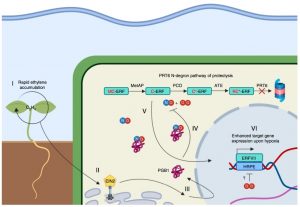 Climate projection models predict an increasingly wetter world with frequent and severe flooding events, causing loss of crops. As it is for other organisms, it is a challenge for plants to stay under water for long periods. However, how plants react to submergence is poorly understood. Environmental perturbations such as submergence are perceived by plants thanks to dynamic changes in gases. For example, oxygen and nitric oxide (NO) control the stability of group VII Ethylene Response Factor (ERFVII) transcription factors. Hartman et al. describe that plants can quickly detect submergence using passive ethylene accumulation and use this signal to induce hypoxia acclimation. The authors propose that ethylene enhances ERFVII stability by increasing the NO-scavenger PHYTOGLOBIN1. This ethylene-mediated NO depletion and consequent ERFVII accumulation prepare cells for impeding hypoxia. The authors proposed a molecular mechanism for the regulation of flooding survival and identified key regulatory targets for the perception of early stress. (Summarized by Francesca Resentini) Nature Comms. 10.1038/s41467-019-12045-4
Climate projection models predict an increasingly wetter world with frequent and severe flooding events, causing loss of crops. As it is for other organisms, it is a challenge for plants to stay under water for long periods. However, how plants react to submergence is poorly understood. Environmental perturbations such as submergence are perceived by plants thanks to dynamic changes in gases. For example, oxygen and nitric oxide (NO) control the stability of group VII Ethylene Response Factor (ERFVII) transcription factors. Hartman et al. describe that plants can quickly detect submergence using passive ethylene accumulation and use this signal to induce hypoxia acclimation. The authors propose that ethylene enhances ERFVII stability by increasing the NO-scavenger PHYTOGLOBIN1. This ethylene-mediated NO depletion and consequent ERFVII accumulation prepare cells for impeding hypoxia. The authors proposed a molecular mechanism for the regulation of flooding survival and identified key regulatory targets for the perception of early stress. (Summarized by Francesca Resentini) Nature Comms. 10.1038/s41467-019-12045-4


